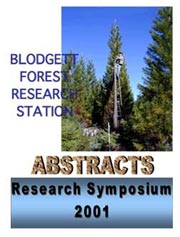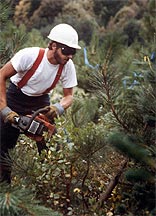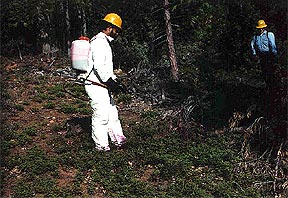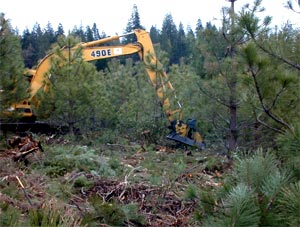 |
||||||||||||||
|
||||||||||||||
| 2001 Blodgett Forest Research Symposium |
| Research Projects | Research Publications | Back to TABLE OF CONTENTS |
|
|||||||||||||||||||||||||||||
A considerable body of evidence points to predisposition of root-diseased conifers to colonization by tree-killing bark beetles. To determine whether root diseased trees are more attractive to bark beetles, landing rates were monitored on trees inoculated with the root and butt rot fungus, Heterobasidion annosum, and compared with landing rates on mock inoculated and uninoculated control trees. In 1997, thirty trees were inoculated at the root collar, thirty mock-inoculated and thirty used as controls in each of two adjacent, stands of 35 year old ponderosa pine (referred to as east and west plots) at the University of California’s Blodgett Forest Research Station (BFRS), Georgetown, El Dorado County, California. Four equally-spaced wooden dowels colonized by H. annosum were inserted at the base of inoculated trees, and four un-colonized, sterilized dowels were inserted at the base of mock inoculated trees. Each of the 180 trees was fitted with four, 0.22 m2 sticky traps made of 3 mm hardware cloth coated with Tanglefoot and sprayed to runoff with the insecticide carbaryl (Sevin, Ortho). Two of the four traps were tied to the trunk 4-5 m above ground, while the other two were tied at the base. All scoytids were removed from the traps in July and November, 1997, and again in July and November 1998, and in November 1999 (the traps were re-coated with Tanglefoot and re-sprayed with carbaryl in May 1998 and May 1999). Differences between the treatments and plots were tested for each species of bark beetle using ANOVA. Trees under attack were eliminated from the analysis as pheromone induced-landings would confound treatment effects. Independently of plot, treatment and year, the mean number of beetles/trap/date in decreasing order of frequency were: Hylastes spp. (0.702), Gnathotrichus spp. (0.340), Ips latidens (0.161), Dendroctonus brevicomis (0.156), I. paraconfusus (0.136), and D. ponderosae (0.043). Differences among treatments were non-significant (a = 0.05), with the exception of I. latidens in the first period of 1998. Overall, the east plot was characterized by higher trapping rates than the west plot (0.308 vs. 0.204, respectively), but the differences between plots were non-significant. However, catches for individual genera/species at each date often differed by plot. Representative data for western pine beetle and the California 5-spined ips are shown in Table 1. Thus, under the conditions of our experiment, bark beetles appear to land on their hosts at random, irrespective of inoculation status. This study will be expanded to correlate bark beetle landing rates with local population sizes and incidence of bark beetle associated tree mortality. In addition, the landing rates of bark beetles on other tree species will be monitored to determine whether landing is host specific in mixed stands of trees. Table 1. Mean number of beetles/trap/date for Ips paraconfusus and Dendroctonus brevicomis. Date refers to the dates that insects were removed from the traps.
|
|||||||||||||||||||||||||||||
Contact Author: Andrew J. Storer, Division of Insect Biology, 201 Wellman Hall, University of California, Berkeley, Berkeley, CA 94720, (510) 642-5806, e-mail: storer@nature.berkeley.edu Pierluigi Bonello and Thomas R. Gordon Department of Plant Pathology, University of California, Davis, CA95616 Pierluigi Bonello Current address: Dept. of Plant Pathology, The Ohio State University, 201 Kottman Hall, 2021 Coffey Road, Columbus, OH 43210 David L. Wood Division of Insect Biology, University of California, Berkeley |
|||||||||||||||||||||||||||||
|
|||||||||||||||||||||||||||||
|
University of California Center for Forestry, UC Berkeley. Last modified: 6/27/02 ©Copyright, 2001. The Regents of the University of California. For questions and comments, contact webmaster. |


 Left:
Left: Left:
Left: